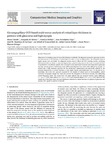Circumpapillary OCT-based multi-sector analysis of retinal layer thickness in patients with glaucoma and high myopia

Use this link to cite
http://hdl.handle.net/2183/40422Collections
- Investigación (FIC) [1685]
Metadata
Show full item recordTitle
Circumpapillary OCT-based multi-sector analysis of retinal layer thickness in patients with glaucoma and high myopiaAuthor(s)
Date
2024-11-19Citation
M. Gende et al., «Circumpapillary OCT-based multi-sector analysis of retinal layer thickness in patients with glaucoma and high myopia», Computerized Medical Imaging and Graphics, vol. 118, p. 102464, dic. 2024, doi: 10.1016/j.compmedimag.2024.102464.
Abstract
[Abstract]: Glaucoma is the leading cause of irreversible blindness worldwide. The diagnosis process for glaucoma involves the measurement of the thickness of retinal layers in order to track its degeneration. The elongated shape of highly myopic eyes can hinder this diagnosis process, since it affects the OCT scanning process, producing deformations that can mimic or mask the degeneration caused by glaucoma. In this work, we present the first comprehensive cross-disease analysis that is focused on the anatomical structures most impacted in glaucoma and high myopia patients, facilitating precise differential diagnosis from those solely afflicted by myopia. To achieve this, a fully automatic approach for the retinal layer segmentation was specifically tailored for the accurate measurement of retinal thickness in both highly myopic and emmetropic eyes. To the best of our knowledge, this is the first approach proposed for the analysis of retinal layers in circumpapillary optical coherence tomography images that takes into account the elongation of the eyes in myopia, thus addressing critical diagnostic needs. The results from this study indicate that the temporal superior (mean difference
11.1 µm, p < 0.05, nasal inferior (13.1 µm, p < 0.01) and temporal inferior (13.3 µm, p < 0.01) sectors of the retinal nerve fibre layer show the most significant reduction in retinal thickness in patients of glaucoma and myopia with regards to patients of myopia.
Keywords
Glaucoma
Myopia
Deep learning
Segmentation
Computer-aided diagnosis
Ophthalmology
Myopia
Deep learning
Segmentation
Computer-aided diagnosis
Ophthalmology
Editor version
Rights
Atribución-NoComercial 3.0 España
ISSN
1879-0771
0895-6111
0895-6111






